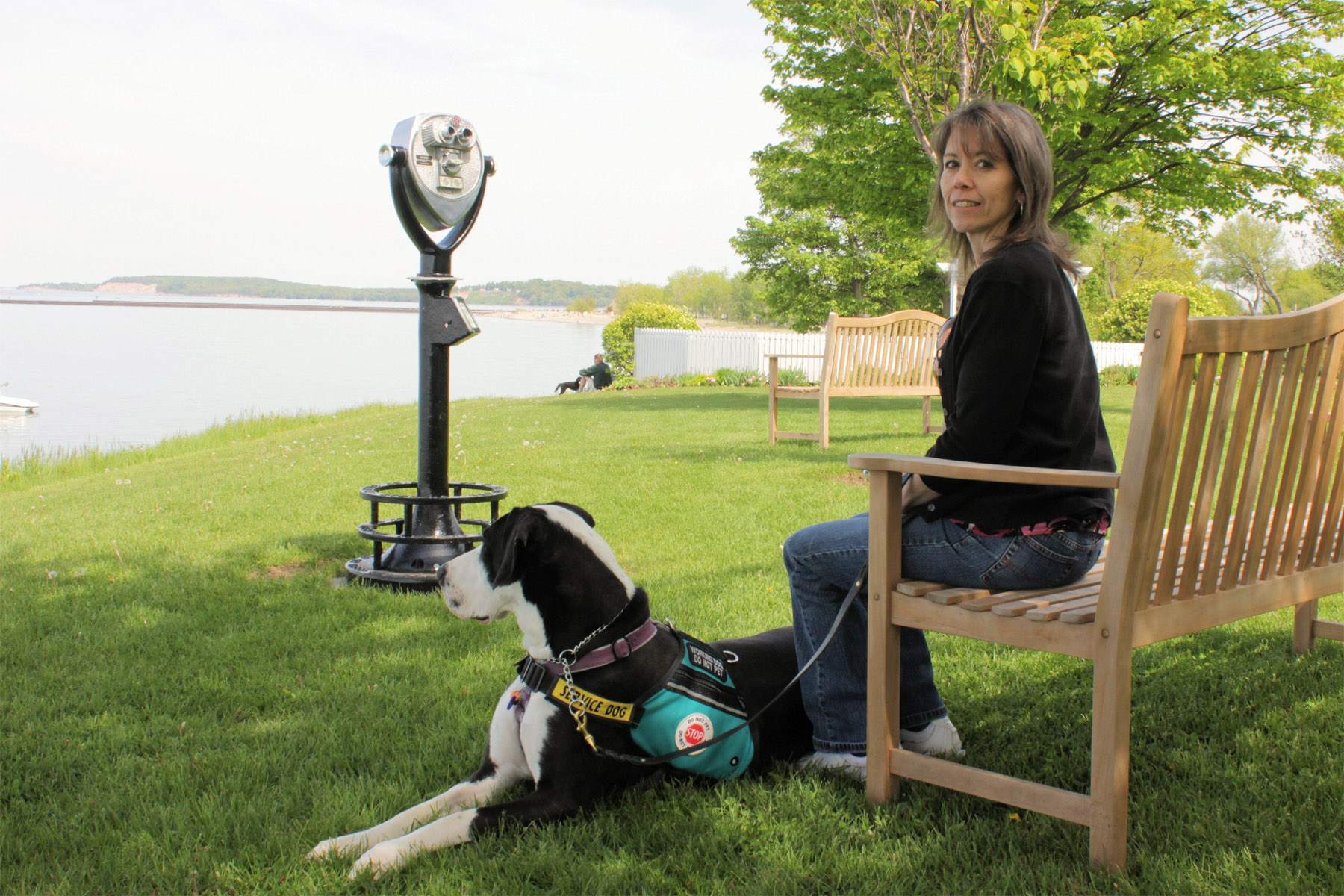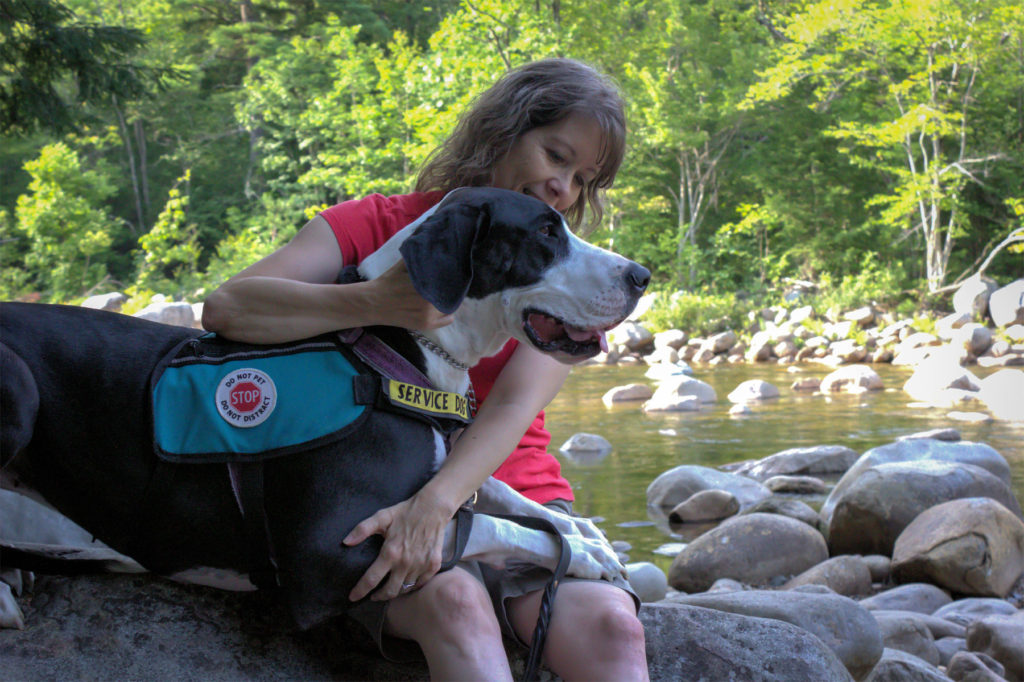
Over the years, I’ve met interesting folks with disabilities who lived the RV lifestyle. Three years ago, at Flathead Lake, Montana, I met a couple whose husband “Mel” loved his diesel pusher so much he withstood two full-length leg braces at the age of ninety-two. My first encounter with a medical alert dog came when Mel introduced me to his wife and her Diabetes Alert Dog (DAD) Golden Retriever sitting outside their motorhome. The dog wasn’t wearing its “service dog” vest, but Mel pointed to the dog stating, “She’ll nudge my wife incessantly when her blood sugar gets out of whack.” The wife spoke up, “She watches me like a hawk.” DADs detect glucose level changes in one’s breath and respond accordingly with remedies such as retrieving glucose tablets or insulin or contact authorities with specialized calling equipment with protocol directions located in a pocket within their service vest.
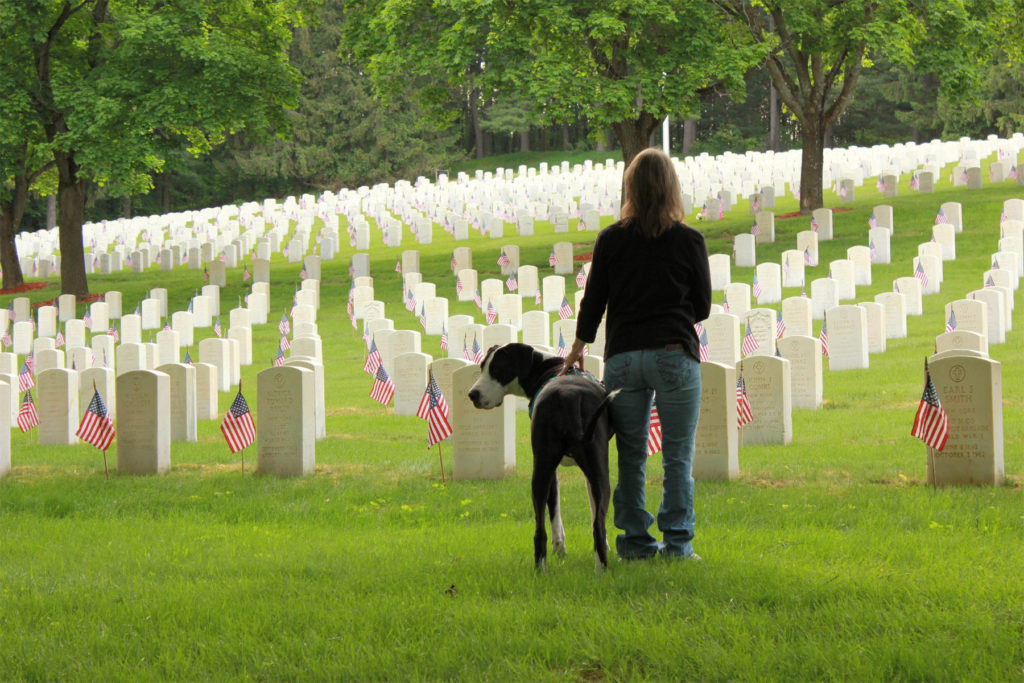
Service Dogs play a vital role in the lives of people with disabilities. According to the Americans with Disabilities Act, service dogs perform specific tasks for people with disabilities. These disabilities can be physical (such as brace/mobility), sensory (medical/allergen alert, epilepsy), psychiatric (PTSD, anxiety or depression) and intellectual (hearing ear/seeing eye) to name a few. Under Federal Law these dogs have full public access rights, allowing them in places where pets or emotional and therapy dogs cannot. A bonafide service dog may begin training as early as 3 to 4 weeks and progress for as much as two years.
Recently, I was knocked off my feet after getting to know Brenda Swarts from upstate New York. What stood out at first encounter was Brenda’s sidekick – Dolly, her Great Dane Service Dog, standing a mere forty-four inches tall. Dolly is considered a medium size Great Dane, but her stature fits Brenda’s needs perfectly. Brenda inherited Charcot-Marie-Tooth disease, a hereditary motor and sensory neuropathy disease that progressively affects the peripheral nerves of her lower extremities. After a handful of hip operations, Brenda’s mobility aid is Dolly, allowing her freedom of movement.

After being near Brenda and Dolly over the past five months, I developed profound respect for Dolly and wanted to learn more about her intuitive nature and training. Dolly was bred and trained by Service Dog Project (SDP) of Ipswich, Massachusetts. Lynn George, Director of SDP, walked me through the levels and intense training that Dolly and other Great Danes go through to become brace/mobility service dogs for their human partners.
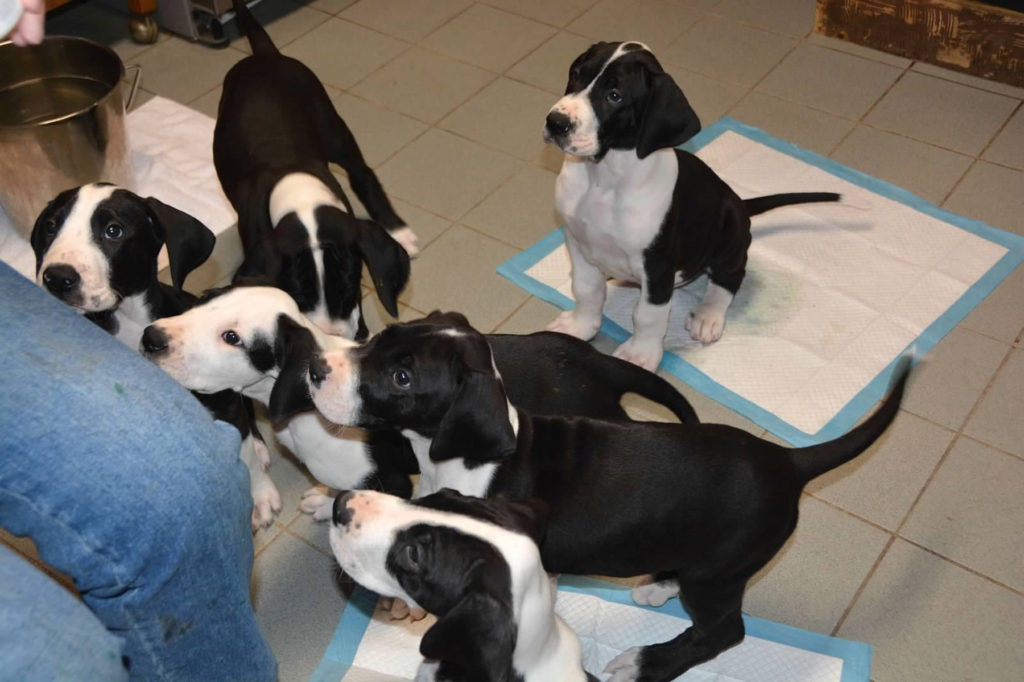
Why Great Danes
SDP chooses American bred Great Danes as they tend to be stockier to help stabilize larger people. Dolly is the right height and stature to assist with stabilizing her petite owner. Dolly is in remarkable shape. Her eyes are a mark of intelligence, yet stealthy. No utterances, just patiently watchful. And if my description of her size means little to you, just think, Dolly’s head is larger than my cat.
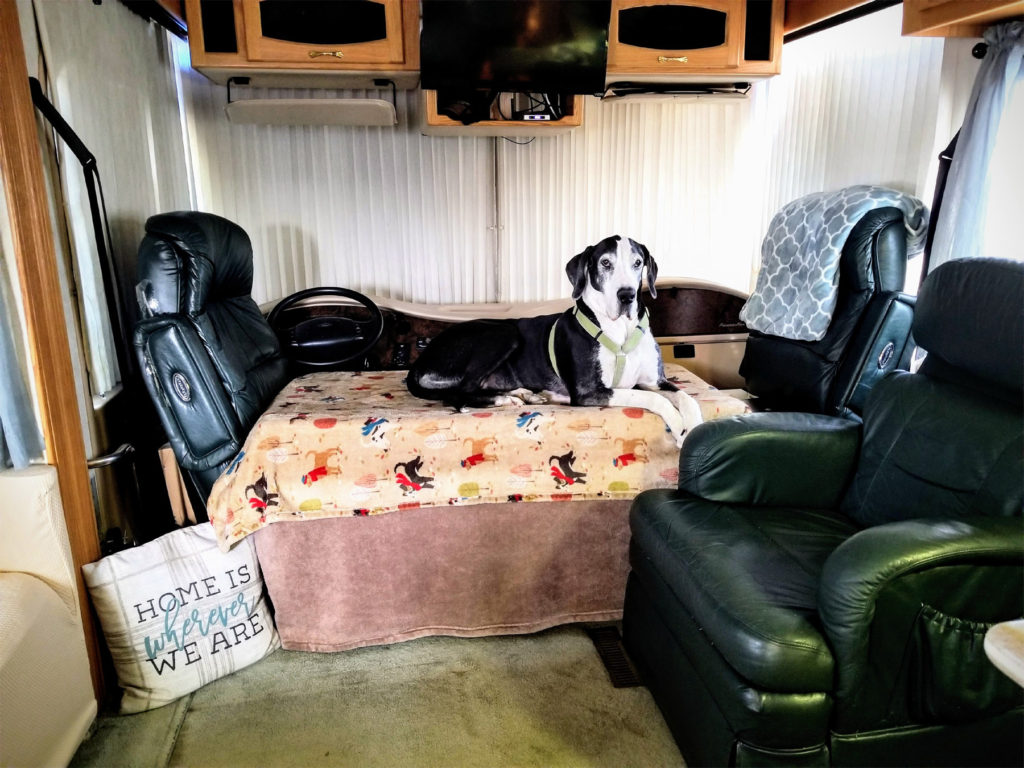
In the five months I worked alongside Brenda and Dolly, Dolly’s behavior boasts one of the most well-trained service dogs I have encountered, period. First and foremost, Dolly possesses the innate sense of monitoring Brenda’s needs immediately responding with stability, love and affection. Yet she is acutely aware she is a service dog and helping Brenda is her only focus. That’s a compliment to Service Dog Project trainers. At home without her service vest, Dolly is like most family pets. She’s playfully, enjoying affection and attention. She doesn’t act like a big dog. You only realize it when she steps on your foot to get close as you’re scratching her head. Dolly’s bed is a repurposing of a firm foundation between the two front captain’s chairs. While traveling, her place is on the sofa.
Beyond Balance and Mobility
One evening at a dinner show I asked Brenda if Dolly ever displayed protective instincts. Brenda reiterated a story of a man who entered the office at closing where Brenda was working. Acting strangely and talking loudly, the man had no business with the office. Hearing stress in Brenda’s voice, Dolly jumped to her feet enlarging her profile behind the counter where Brenda was standing, never taking her eyes off the stranger. Dolly did not bark. Instinctively, she deftly maintained her stance uttering a low-toned growl without being aggressive – the mark of being well-trained. The stranger got the message and swiftly departed. Dolly and Brenda locked the glass door and Dolly watched the individual until he was no longer in view. A hallmark of Dolly’s (and well-trained service dogs) is their level of restraint and discipline. Brenda had no doubt Dolly would have become protective if the incident heightened.
For more than 15 years, my spouse and I worked with several classes of public service and military working dogs as well as task-trained canines for hearing ear, seeing eye, psychiatric and medical needs. Guide dogs for the blind and visually impaired help their master navigate everyday life. For those who are trained to detect low or high blood sugar for diabetics, those medical alert service dogs are trained to nudge or force their owner to take action to correct their blood sugar level while they are conscious.
Service Dog Etiquette
For folks who love dogs, it is difficult to restrain oneself from interacting with these creatures as we encounter them when we’re out and about. Regrettably, most folks do not understand how to act around a genuine service dog when they are working (donning their service vest). Children especially want to rush forward and pet the dog. Here are some hard fast rules set forth by the American Disabilities Act and the Federal Law that protects service dogs as a class of their own.
First, interacting with a “Service Dog” without consideration for its owner is a distraction from the dog’s task(s). Rather, you, the encountering individual, should:
- avoid direct eye contact
- restrain yourself from touching or petting
- do not talk or offer food
Children should be apprised by the parent in advance before they enthusiastically approach a working Service Dog. Yes, it’s difficult, but bonafide service dogs are trained to ignore distractions. They are not celebrities, nor toys to be played with. I’ve run into comfort dogs while shopping as they ride inside the grocery cart or on the owner’s lap while navigating store aisles in a motorized scooter. Many of these companions wear a ‘comfort dog’ insignia on their harness. Most are too small to be any service other than emotional support or medical alert training.
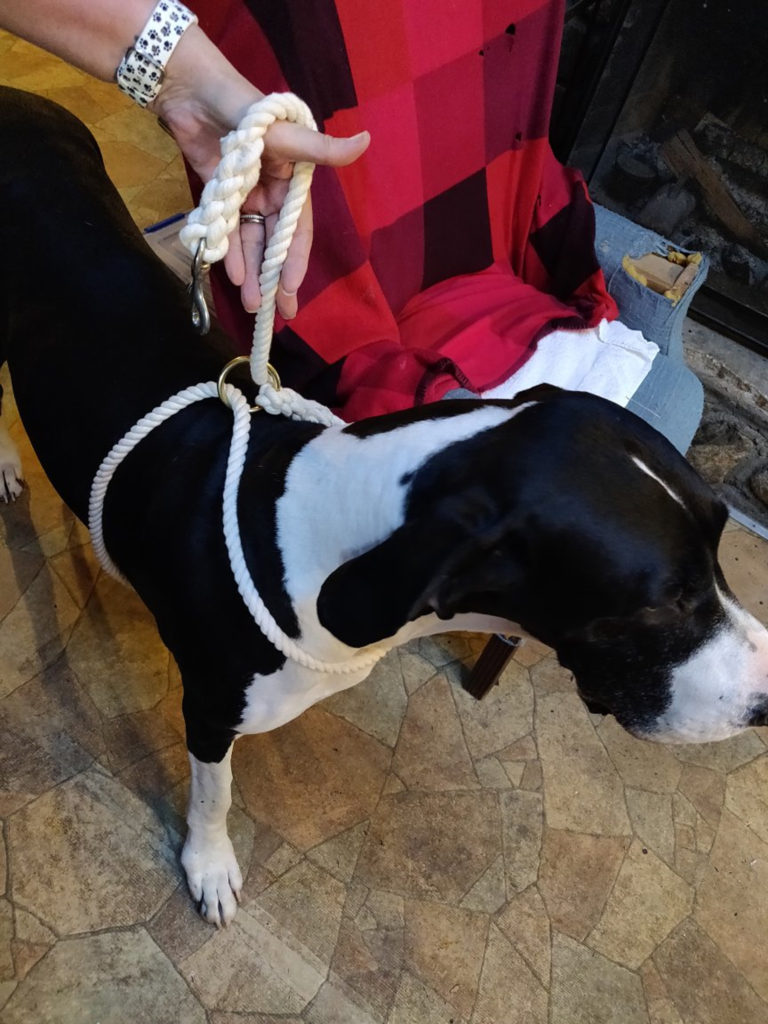
Don’t get me wrong, I love dogs, cats and other animals, I am against people merely dubbing their pets a “service dog” when they are no more than a companion, and more so when the dog is not well-trained. My business collaborated with canine handlers worldwide and I’ve encountered many canine heroes, the kind who have saved countless lives. I’ve met a few canines whose talent was well beyond protective detail or using their olfactory senses for a myriad of scent detection avenues. In the beginning stages of service dog training, there are various facets that determine strengths and weaknesses of a pup selected for preliminary training as a service dog. Qualified facilities like Service Dog Project look at the pup for alertness and cognitive behavior. Can they listen and obey? Lynn George mentioned pup training begins at 3-4 weeks, or as soon as their belly is off the floor. The first in a sequence of training is to get them to sit by spoon feeding them baby food and train them to learn their name and wait for the cue as indicated by this picture . . . .
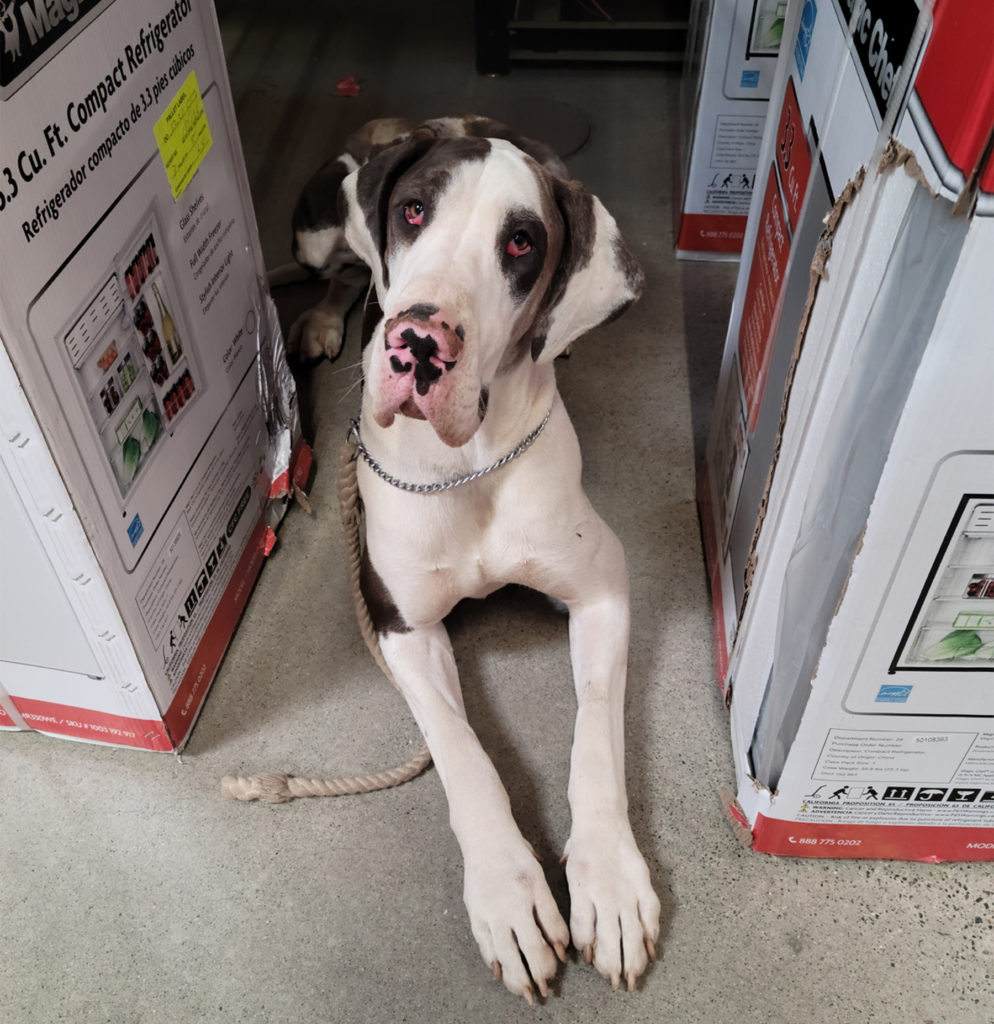
One day at Planet Fitness I encountered a middle-aged woman on a rowing machine with her Pitbull Service Dog lying quietly by her side. Knowing it was a service dog I introduced myself as having been around a myriad of scent detection and working canines for years in search and rescue and was curious as to the dog’s specialty discipline. It happened to be medical alert dog trained to detect and respond to her human partner at the onset of an epileptic seizure. As we chatted, she lovingly scratched her dog’s ears while she related that her canine partner is trained to lick her face to ensure she is conscious or to bark to summon assistance. I asked her if such a situation had occurred and she smiled saying, “Yes, she prods making sure I’m awake.”
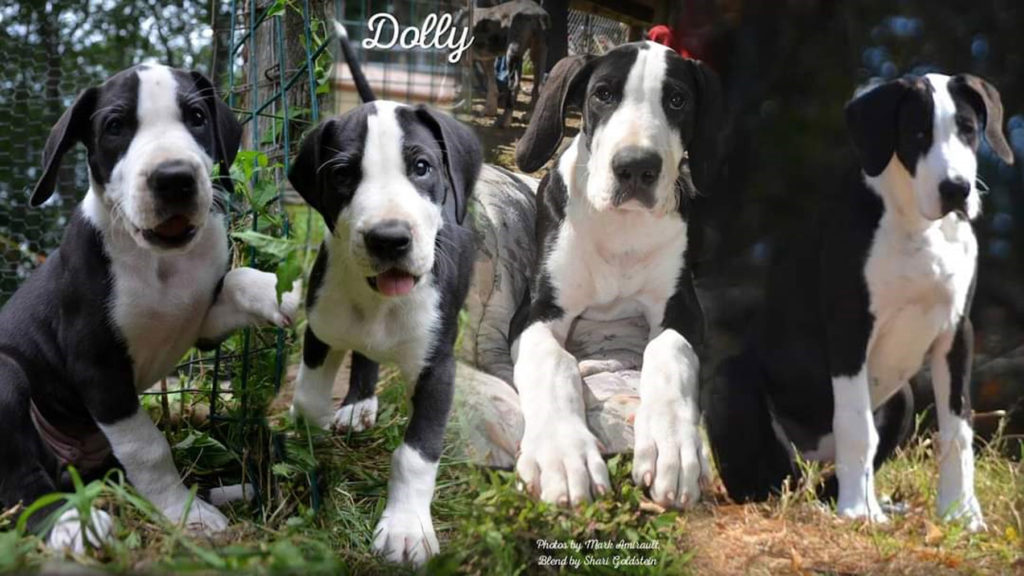
Dolly gives her best friend and owner the ability to enjoy RVing without limits, never giving up the liberty we take for granted. So, the next time we grumble about the size of our RV, just imagine what it’s like to have your movement restricted while sharing with another living creature. Without Dolly, Brenda would experience constraints to RVing! While Dolly is my husband’s new girlfriend… Dolly is Brenda’s hero.
If you want to brighten your day, visit SDP’s website and scroll through the pictures of these soon to be canine hero’s. You’ll be happy you did.
Helping Remotely | My Site (servicedogproject.org)
You can read the published article on FMCA Family RVing Lifestyle here: Family RVing Magazine – November 2022 (advanced-pub.com)
